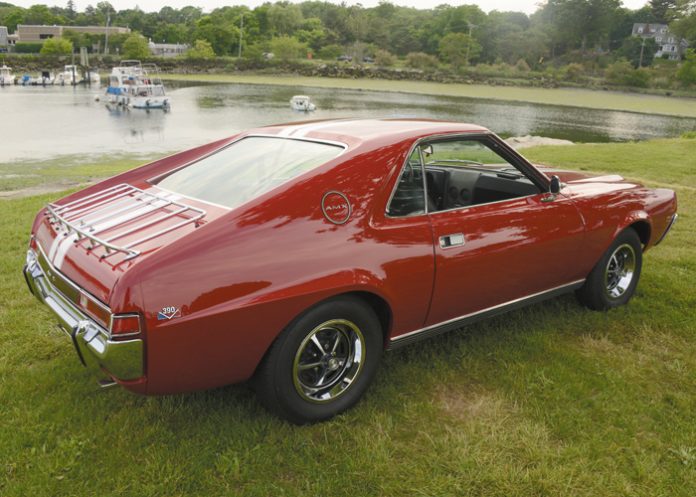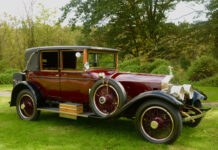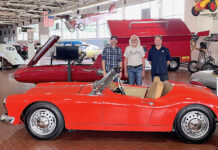By Jay Hirsch
The 1968 AMC AMX is a true “pony car.” It was a two-seat sports car/muscle car that was made by American Motors from 1968 to 1970. It was AMC’s response to the Camaro, Firebird, Dodge Challanger/Plymouth Barracuda and the original Pony car, the Mustang.
The AMX was the first two-seat sporty car since the 1955–1957 two-seat Thunderbird, the two-seat 1954 Kaiser Darrin and the two-seat Corvette, which was introduced in 1953. The AMX was an all-steel-bodied car and was a kid brother to the larger four-seat Javelin, also introduced in 1968. The AMX was 177.2 inches long, 51 inches tall and had a wheelbase of 97 inches, which was one inch less than a Corvette. The automobile press of the time period called the AMX the “Corvette competitor.”
With the optional high-performance 390 (6.4 liter) OHV V-8, the AMX offered great performance at an affordable price. In spite of the high praise by the automobile media the automobile public never warmed up to the AMX. The 1970 AMX was the last year for the two-seat AMX, and in 1971 it was replaced by the bigger four-seat Javelin, which was first made in 1968
The name AMX originates from AMC’s concept car, the “eXperimental,” that was displayed on the 1966 new car show circuit. The AMX was introduced to the press and the public on Feb. 15, 1968, at the Daytona Speedway as the “only American sports car that costs less than $3,500.” The Corvette cost $1,000 more.
The AMX came with a 4 bbl, 290 cid OHV V-8. Optional engines were a 343 cid OHV V-8, a 360 cid OHV V-8 and the high-performance 390 cid OHV V-8. All engines were available with either automatic or manual transmissions.
For promotional purposes, AMC’s Performance Manager Carl Chakmakian got Craig Breedlove to put the AMX through some paces before it was introduced to the public. With heavy-duty front and rear springs, exhaust headers, a racing camshaft, solid lifters and larger carburetor, Breedlove recorded a speed of 189 mph at Bonneville in a United States Auto Club sanctioned event. Breedlove also recorded a speed of 200 mph in an unofficial run with the 390 cid OHV V-8.
The high-performance 390 V-8 came with a manual Borg Warner T-10 floor-mounted four-speed transmission. A “shift command” three-speed automatic transmission, which was capable of manual shifting, was an option.
With the 343 V-8 and the 390 V-8 came power front disc brakes, dual exhaust, twin grip differential, E70 x 14 red-stripe performance tires on Magnum 500 wheels, heavy-duty front suspension, heavy-duty cooling, thicker sway bars and other specialized performance parts through dealers.
Vic Raviolo, who was responsible for the Lincolns that raced in the 1952–1954 Carrera Panamericana (also known as the Mexican Road Race), was involved with the engineering of the new AMX. Vic called the AMX “the Walter Mitty Ferrari.” The AMX was designed to appeal to both the sports-car-minded person and the muscle-car enthusiast, depending on which engine the buyer chose. Automotive writer Tom McHaill said of the AMX, “The AMX the hottest thing to come out of Wisconsin (where AMC was headquartered)…. You can whip through corners and hard bends better than many out-and-out sports cars”
The AMX seen here is an original-owner car. In the spring of 1968 Harvey Truppi ordered a 1968 Camaro at a local Chevrolet dealer in Bergen County, N.J., and gave a deposit on the car, which was to be made and delivered in five weeks. When the Camaro came in five weeks later, the salesman (there were no women in car dealerships then) called Harvey. When Harvey arrived at the showroom, the salesman said there was “a minor problem”—he could not give Harvey as much for his trade-in 1965 Impala than he had originally said. Harvey asked for his deposit back and walked out of the showroom. The next day Harvey passed by an AMC dealer, and there on the showroom floor was a red AMX with two white stripes on the center of the car. Harvey parked his Chevy and walked into the showroom.
“I had read a few articles on the AMX, and the pictures I saw of the car the styling impressed me. Seeing it up close on the showroom floor, I was really impressed. The salesman came over to me, and I asked if I could take a test ride. He asked me if I could come back later that day or tomorrow, since the car did not have a battery in it. I returned the next day, and took the car for a ride. Obviously I liked it. The car handled better than the Camaro, and that 390 engine was incredible. I worked out a deal with the salesman. By now I decided to keep the 1965 Impala, so it was a straight new-car deal with no financing. I had the money in the bank, and the car cost less than the Camaro. The salesman then said, ‘there is small problem,’ and I thought, ‘Here we go again.’ The problem was it the ws only AMX the dealer had, and they were not getting another one until next week. If they could keep the car on the showroom floor, locked so no one could sit in it, the salesman would give me a chromed luggage rack for the trunk.”
Harvey picked up the AMX the following week and used the AMX daily until the late 1990s. Eventually the body started to show the effects of winters on the road. Harvey and his wife liked the car too much to see it go and decided to do a full restoration on the car. In 2001, the 390 was rebuilt and new fenders wee installed, along with whatever else the AMX needed.
Since 2002 the AMX only see’s sunny days, and the smile on Harvey’s face everytime he fires up that 390. •



